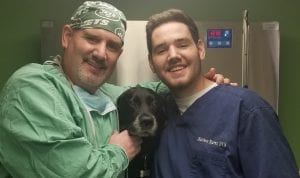Ask the Vet: Canine influenza virus — Mapping the disease
By Matthew Kearns, DVM

There has been a lot of media attention about outbreaks of the canine influenza virus (CIV), but very little known about how to predict it’s spread.
Dr. J. Scott Weese of the University of Guelph, Ontario hopes to put an end to that. CIV strain H2N8 was first reported in racing greyhounds in Florida in 2004. Milder cases only cause coughing and transient fever. However, more severe cases can lead to severe pneumonia. Approximately 2% of cases are fatal. Fatalities are usually limited to older dogs or dogs with preexisting health conditions.
In April, 2015, an outbreak of the CIV occurred in the Chicago area that affected more than 1,000 dogs and led to eight deaths. Another outbreak shortly after the Chicago incident occurred in the Atlanta area affecting approximately 80 dogs (no deaths).
In December 2015, another outbreak occurred in the Seattle area affecting approximately 80 dogs (again, no deaths). Interestingly, none of the cases in 2015 were caused by the CIV H3N8 strain, but rather an H3N2 strain. The H3N2 strain was previously only seen in Asia (first diagnosed in 2006-2007). It is believed that this Asian strain gained entrance to the United States through Chicago’s O’Hare Airport inside a dog from Korea.
Fast forward to today and Dr. Weese: between August of 2022 and January of 2023, 200 veterinarians reported cases in Alabama, Arizona, California, Georgia, Illinois, Maryland, Missouri, North Carolina, Oklahoma, Oregon, Pennsylvania, South Carolina, Tennessee, Texas, and Virginia.
What Dr. Weese has concluded from the initial information is that CIV differs from human influenza virus in one distinct way. Where the human influenza virus is seasonal based on changes in behavior (people spending more time indoors in closer proximity to each other). CIV spread is more sporadic and year-round.
CIV is passed from dog to dog via aerosolized respiratory secretions from coughing, barking, sneezing, contaminated objects (food and water bowls, kennel surfaces) and people moving between infected and uninfected dogs. Dogs that stay at kennels, groomers, doggy day care, parks etc. are more at risk. This also explains why CIV outbreaks are sporadic and occur year-round.
Vaccines for both known strains (H3N8 and H3N2) are available for dogs at this time. The goal of the vaccine is to expose the host (in this case dogs) to a weakened or inactivated form of the virus and stimulate the immune system to produce antibodies against it. This will prevent severe forms of the disease but will not prevent infection, nor prevent shedding of the virus.
We hope that as Dr. Weese gets more data a better map of the spread of this disease. Until that time please consult with your veterinarian as to whether your dog is at risk for the CIV virus (H3N8 or H3N2 strain) and whether a vaccine is warranted.
Dr. Kearns practices veterinary medicine from his Port Jefferson office and is pictured with his son Matthew and his dog Jasmine.







